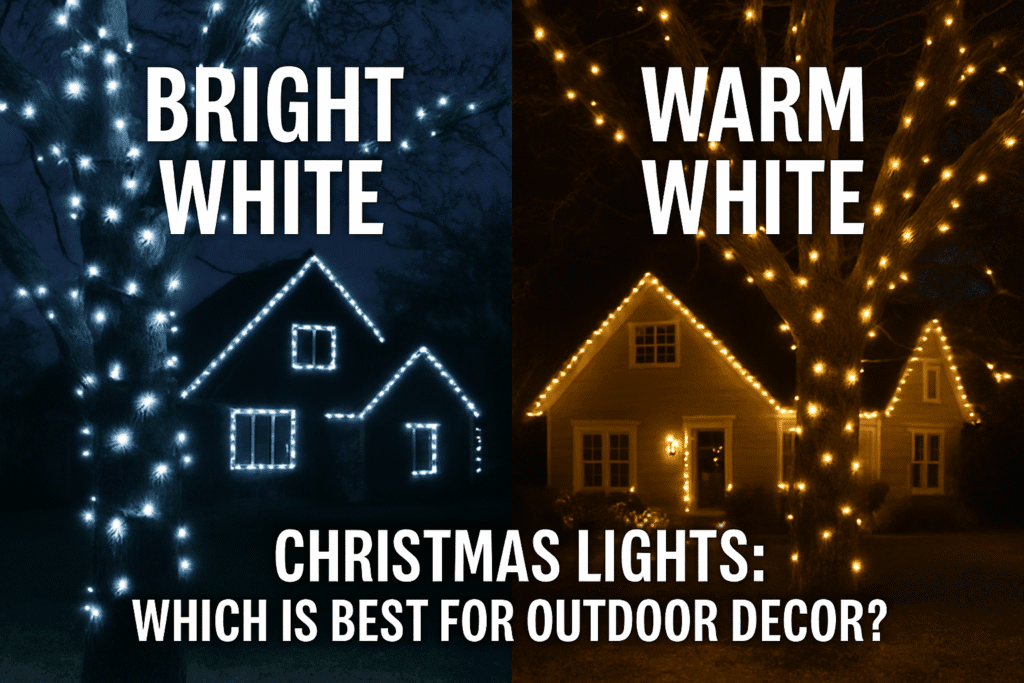Choosing the right Christmas lights can be frustrating, especially when deciding between bright white and warm white options. The wrong choice can clash with your garden’s style or create an unwanted mood. Let’s break down the key differences so you can light up your outdoor space beautifully this holiday season.

Bright white (cool white) Christmas lights produce a crisp, bluish glow, perfect for modern or snowy themes. Warm white lights give off a soft, yellow-toned hue, ideal for cozy, traditional vibes. Outdoors, bright white stands out in icy displays, while warm white enhances garden warmth and charm. Your choice should match your decor style and desired ambiance.
Now that you know the basic difference, let’s explore how each type performs outdoors, which fits best with garden décor, and the pros and cons of each style.
Should Christmas lights be warm or bright white?
It depends on the atmosphere you want to create. Warm white Christmas lights bring a golden, nostalgic tone, pairing well with red, green, and gold ornaments. They’re perfect if your goal is a cozy and inviting garden. In contrast, bright white lights, often referred to as cool white, are excellent for creating a snowy, winter wonderland feel, especially when combined with silver or blue decorations.
So, if you’re decorating a cottage-style garden or vintage outdoor setup, warm white is your go-to. For sleek patios or minimalist landscaping, bright white wins.
Is warm white or bright white better for outdoor garden decor?
In garden settings, warm white lights often blend more naturally with outdoor greenery and traditional decor. They look beautiful when wrapped around trees, hedges, or pergolas, giving off a candlelight-like softness.
Bright white lights, however, are great for highlighting structural elements like fences, walkways, or sculptures. Their sharper contrast makes them more visible in darker environments, especially in snowy areas. Think about your landscaping elements: Are they natural and soft or modern and angular?
👉 Pro Tip: Use warm white lights in trees and garden beds, and bright white along paths or structures for a layered effect.
What is the best color for Christmas lights for gardens?
While golden hues are traditionally the most popular for their comforting glow, gardens offer more flexibility. Warm white lights work best if your goal is subtle elegance, especially with rustic, English-style gardens.
On the other hand, pure white or cool white lights are ideal if you want your garden to stand out from the street or capture that icy, festive look.
It also depends on your Christmas theme. Going with natural elements and wreaths? Use warm white. Decorating with metallics or crystal decor? Bright white is best.
Are bright white Christmas lights better for visibility?
Yes. Bright white LED lights are generally better for illumination and visibility, especially for highlighting paths, walls, and ornaments. If your outdoor area gets very dark at night, bright white lights might help define space and reduce tripping hazards.
However, there’s a tradeoff: bright white can appear harsh or sterile, especially in peaceful garden settings. If you’re hosting guests outdoors or want a more relaxing ambiance, you might prefer warm white despite its lower brightness.
Also, consider your lighting power source. LEDs in either color are more energy-efficient than incandescent bulbs. See comparison chart here for detailed specs. (Placeholder link)
What are the disadvantages of warm white lights outdoors?
While beautiful, warm white lights have a few drawbacks when used outdoors:
- They can appear too dim in very open or poorly lit areas.
- If you have a lot of bright-colored decor, the soft yellow hue might get lost.
- They offer less contrast compared to cool white, so design elements might blend in more.
Still, for many, the soft, cozy glow outweighs these minor issues—especially if you’re decorating for ambiance over utility.
Can you mix cool white and warm white lights in your garden?
It’s possible, but be careful. Mixing both can create visual dissonance if not done thoughtfully. Some decorators on Reddit say mixing feels like a faux pas, while others like the contrast.
If you do mix:
- Use warm white for the bulk of foliage and trees.
- Use bright white for outlining fences, windows, or rooftops.
- Avoid mixing them on the same structure, like a single hedge or tree.
Experiment first with a small section to see how it looks at night.
What’s the difference between pure white, cool white, and warm white lights?
Here’s a quick breakdown of white Christmas light types:
| Type | Appearance | Best For |
|---|---|---|
| Warm White | Yellow/golden glow | Cozy, traditional decor |
| Cool White | Bluish tint | Modern, icy displays |
| Pure White | Neutral white | Balanced look for mixing styles |
Pure white is a happy medium and works well if you want a white glow without leaning too warm or too cold. It’s also great if you’re unsure about your design theme.
Summary
Whether you choose warm or bright white lights, your garden will shine with holiday spirit when you match the color to your style. Want cozy charm? Go warm. Prefer a modern sparkle? Go bright. Share your setup below—and tag us in your garden light photos this season!
